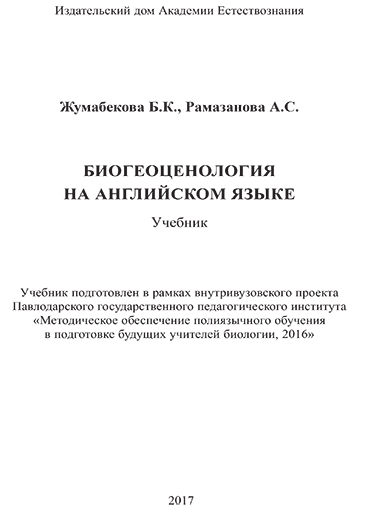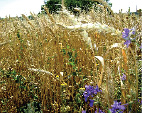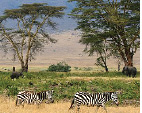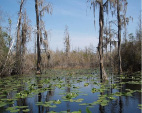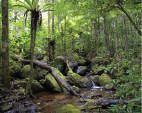
Научная электронная библиотека
Монографии, изданные в издательстве Российской Академии Естествознания
Chapter 11. BIODIVERSITY, ITS MONITORING AND PROTECTION
|
Essential targets: By the end of this chapter you should be able to answer the following questions: What is a biodiversity? Why it is important to protect a biodiversity? |
Read the given text. Write out the key words. Create a mind map (spider diagram) to show what you have learnt about the biodiversity / Мәтінді оқып шығыңдар. Түйінді сөздерді жазып алыңдар. Биоәртүрлілік туралы не білгендеріңді көрсету үшін ассоциативті карта (өрмекші-диаграмма) құрыңдар / Прочитайте текст. Выпишите ключевые слова. Создайте ассоциативную карту (диаграмму-паук), чтобы показать, что вы узнали о биоразнообразии.
Biodiversity is the diversity among and within plant and animal species in an environment. This can refer to genetic variation, ecosystem variation, or species variation within a specified area. The term biodiversity was coined by Walter G.Rosen in 1985.
Biodiversity of species includes the number of species on Earth, of separate countries, of places or ecosystems/biotopes/habitats.
There are different types of biodiversity can be observed in nature, they are
(1). Genetic diversity: diversity in the alleles of a single gene
(2). Organismal diversity: differences in morphology, anatomy, behavior of organisms
(3). Population diversity: variations observed quantitative ecological parameters such as frequency, density, abundance etc.
(4). Species diversity: Measures the species number variations in different genera at a particular habitat
(5). Community diversity: variability among community composition of and ecosystem and variations in the ecological interactions
(6). Ecosystem diversity: deals with the variations of interdependence of biotic and abiotic factors in the ecosystem
(7). Landscape diversity: measures the species composition in different landscapes
(8). Biogeographic diversity: diversity observed in geological and geographic history over a large period of time [1].
Biodiversity change can be a natural or a man-driven phenomenon. When man-driven, biodiversity change occurs fast and is often irreversible.
BIODIVERSITY MONITORING
This monitoring is organized depending on the type of biodiversity studied. The counts of species include detail studies on their abundance and biomass, and morphological peculiarities. For many species their age, health, fatness and many other parameters are also investigated.
Biodiversity monitoring takes place on an annual basis, as for some species, the frequency of observations may go up to a daily sampling at certain stations (for instance, in the case of phytoplankton). Especially important domain of biodiversity monitoring is tracing the status of threatened species enlisted in the following IUCN categories:
Critically endangered
Endangered
Vulnerable
All the visible features of an area of land, often considered in terms of their aesthetic appeal.
For more information on IUCN species categories and related criteria see [2].
BIODIVERSITY MANAGEMENT,
INCLUDING CONSERVATION MEASURES
Biodiversity conservation and protection are regulated by numerous national, regional and global legal and policy documents.
Protection relies mainly on preventive measures, while conservation deals at large with species which were found threatened and/or close to extinction (IUCN Lists).
In biodiversity management the following threats are taken into consideration:
Habitat destruction (physical loss, smothering, sealing, pollution, etc.)
Introduced and invasive species, including genetic pollution
Overexploitation of commercial species
Hybridization, genetic erosion
Climate change The increasing human overpopulation on Earth is also among considered threats.
Measures:
Designation of various types of protected areas with related restrictions of human activities
Control on export/import of plants and animals
Control on introduced species (on purpose and accidental)
Quotas on commercial species
Control on hunting, fishing and any types of human activities which lead to species abundance decrease
Control on human activities which lead to any type of habitat destruction/degradation
Etc.
As in all domains of environmental protection, biodiversity is also protected through raising public awareness and education [3].
Glossary of essential terms / Негізгі терминдер глоссарийі / Глоссарий основных терминов
|
№ |
English term |
Kazakh equivalent |
Russian equivalent |
|
1 |
danger |
қауіп |
опасность, угроза |
|
2 |
destruction |
бұзылуы |
разрушение |
|
3 |
fast |
тез |
быстро |
|
4 |
frequency |
жиілік |
частота |
|
5 |
hunting |
аңшылық |
охота |
|
6 |
protection |
қорғаныс |
защита |
|
7 |
quantitative |
саңдық |
количественныый |
|
8 |
rely |
сену |
полагаться |
|
9 |
tracing |
қадағалау |
прослеживание |
|
10 |
vulnerable |
осал |
уязвимый |
|
Questions: What is biodiversity? What types of biodiversity are there? What is the aim of the biodiversity monitoring? What is meant the biodiversity management? What factors impact to the biodiversity? What conservation measures are included to the biodiversity management? |
|
Key phrases and sentences / Түйінді сөздер мен сөйлемдер / Ключевые фразы и предложения 1. Biodiversity is …/ Биологиялық алуан түрлілік дегеніміз …/ Биоразнообразие – это … 2. There are following types of biodiversity: …/ Биологиялық алуан түрліліктің түрлері: …/ Существуют следующие типы биоразнообразия: ... 3. Biodiversity needs in … and … monitoring/ Биоәртүрлілік ... және ... мониторинг талап етеді/ Биоразнообразие требует … и … мониторинга 4. The aim of biodiversity monitoring is …/ Биоәртүрліліктің мониторинг мақсаты: …/ Цель мониторинга биоразнообразия ... 5. The following factors threaten to the biodiversity: …/ Биоәртүрлілікке қауіп төндіретін факторлар: …/ Факторы, угрожающие биоразнообразию: … |
I. Read the text and answer the question, why should we care about biodiversity? / Мәтінді оқып шығыңдар және не себептен біз биоәртүрлілікке қамқор болуымыз керек деген сұраққа жауап беріңдер / Прочитайте текст и ответьте на вопрос, почему мы должны заботиться о биоразнообразии?.
Biodiversity is extremely important to people and to the health of our natural ecosystems. Here are just some of the reasons:
Biodiversity allows us to live healthy and happy lives. It provides us with a wide array of foods, fibers and other materials and it supports the economy.
Without a diversity of pollinators, plants, and soils, we would have little variety in our diets.
Most medical discoveries to cure diseases and lengthen life spans were made because of research into plant and animal biology and genetics. Every time a species goes extinct or genetic diversity is lost, we lose an opportunity to find out if it could have provided a new vaccine or drug.
Biodiversity is an important part of the ecological services that make life livable on Earth. They include everything from cleaning water and absorbing chemicals, which wetlands do, to providing oxygen for us to breathe – one of the many things that plants do for people.
Biodiversity allows ecosystems to adjust to disturbances such as extreme fires and floods. In a forest with 20 species of reptiles, if one becomes extinct the others will likely adapt to fill the role left vacant. But if the forest had only one reptile species, there can be no adaptation.
Genetic diversity prevents diseases and helps species adjust to changes in their environment.
Diversity enriches our lives simply by existing. There are few things as beautiful, wonderful and inspiring as the diversity of life on Earth [4].
II. Use Internet resources, dictionaries, scientific literature, and find different definitions of term “Biodiversity”. Compare them and explain their distinctions / Ғаламтор қорлары, ғылыми әдебиет, сөздіктерді пайдалана отырып, «Биоәртүрлілік» терминінің түрлі анықтамаларын табыңдар. Оларды салыстырыңдар және ерекшеліктерін түсіндіріңдер / Используя Интернет-ресурсы, словари, научную литературу, найдите различные определения термина “Биоразнообразие”. Сравните их и объясните их различия.
III. Look at the picture and explain what does threat to biodiversity. What role does human play in biodiversity state? / Суретті қарап шығыңдар және биоәртүрлілікке қандай қауіп төніп тұрғанын түсіндіріңдер. Адам биоәртүрлілік жағдайына қалай әсер етеді? / Рассмотрите рисунок и объясните, что угрожает биоразнообразию. Как человек влияет на состояние биоразнообразия?
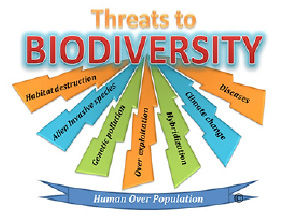
Figure 7. Major Threats to Biodiversity by Human Activities [5]
IV. Look at the pictures. Give the title for them. Describe these pictures according the plan: geographical position, climate, plants, animals, significant for human. Put the figure numbers according to the increase of biodiversity trends. Why is biodiversity is higher in the tropics than in colder regions? / Суреттерді қарап шығыңдар. Оларға атау беріңдер. Жоспарға сәйкес суреттерді сипаттаңдар: географиялық орны, климат, өсімдіктері, жануарлары, адам үшін маңызы. Биоәртүрліліктің ұлғаюына байланысты суреттерді нөмірлеңдер. Не себептен тропикта суық аймақтарға қарағанда биоәртүрлілік жоғары? / Рассмотрите рисунки. Дайте названия для них. Опишите рисунки согласно плану: географическое положение, климат, растения, животные, значение для человека. Расставьте номера рисунков в порядке возрастания биоразнообразия. Почему в тропиках биоразнообразие выше, чем в холодных регионах?
|
|
|
|
|
|
|
|
|
V. Make the dictionary (English – Kazakh - Russian) on the key words of the chapter / Тараудың түйінді сөздерінен сөздік (ағылшынша-қазақша-орысша) құрыңдар / Составьте словарь (английский – казахский – русский) по ключевым словам из главы.
|
SUMMARY Biodiversity – definition: “variability among living organisms”. Bio = a prefix meaning life and Diversity = a variety. The term Biodiversity is coined by Walter Rosen, 1985. About 50 million sps. of plants, animals & microbes are existing in the world. Among this only 2 million are identified so far. There are different types of biodiversity. Biodiversity indicate the health of ecosystem. The rainforest ecosystem, for instance, has a lot of biodiversity. There are a lot of different living organisms in this one area. Biodiversity, besides its ecological significance, provides a socio-economic asset to the nation. |
 Topics for essay:
Topics for essay:
1. The origin of the term “biodiversity”.
2. Classification of biodiversity.
3. The reasons for the decline of biodiversity.
4. Protection of biodiversity.
5. The factors affecting biodiversity.
6. Evolution of biodiversity.
7. The diversity of fauna of the Earth.
8. The diversity of flora of the Earth.
9. The diversity of microorganisms of the Earth.
10. Biodiversity in Kazakhstan.
 References:
References:
1. EBC Easy Biology Class // http://www.easybiologyclass.com/biodiversity-introduction-definition-classification-importance-measurement-of-biodiversity/
2. Biodiversity monitoring // https://portals.iucn.org/library/efiles/documents/RL-2001-001-2nd.pdf
3. Ecological Monitoring and Management of the Environment // http://www.bs-hotspots.eu/Documents/Deliverables/Guideline%20for%20Public%20Organizations%20(ENG).pdf
4. National WILDLIFE Federation // http://www.nwf.org/Eco-Schools-USA/Become-an-Eco-School/Pathways/Biodiversity.aspx
5. EBC Easy Biology Class // http://www.easybiologyclass.com/major-threats-to-biodiversity-human-activities/
